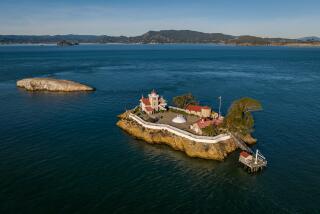Imagine a Different Beach for Every Day of Year
- Share via
ST. JOHN'S, Antigua — When next you dream of a Caribbean getaway, let your fantasies drift back to the year 1493 and to a small island with 365 beaches . . . one for every day of the year.
It was in 1493 that Christopher Columbus made his second voyage to the New World he had discovered a year earlier. Sailing past an island one sunlit morning, he named it Santa Maria la Antigua to honor a miracle-working saint memorialized in the Seville Cathedral of Spain.
Heading onward in search of a route to the fabled gold of the Indies, Columbus never did set foot on this island.
Antigua still doesn’t get the headline attention that goes to Puerto Rico, Jamaica, Haiti, Trinidad and other islands in these waters, but travelers from as far away as Australia are finally starting to make the landing that Columbus didn’t.
A Beach a Day
This small island of only 108 square miles really can offer a different beach for every day of the year. Queen Elizabeth II once chose her own secluded beach among the 365, and this was the only recorded occasion of Her Majesty stepping out into the ripple of surf.
The beaches are only the beginning of getting to know the island--its capital city of St. John’s, scenic roads like Fig Tree Lane, the pineapple and sugar-cane countryside, plus golf courses and resorts. Don’t forget the historical treasure of Nelson’s Dockyard, where the legacy of Admiral Horatio Nelson includes an inn of Georgian studios and suites within a restoration still named the Copper & Lumber Store.
Together with its smaller sister island of Barbuda, Antigua has been an independent state in the Leeward Islands of the eastern Caribbean since Nov. 1, 1981. A governor-general represents the British Crown, but the actual executive power is vested in a prime minister who is a member of the island state’s parliament.
Visitors arriving by cruise ship, as my wife and I did recently aboard the Sun Viking of the Royal Caribbean Cruise Line, have options for exploring Antigua by buses, rental cars, taxis with a driver guide, rental cars, and snorkeling and scuba cruises along the beaches and coral reefs. There is also a sightseeing party boat.
St. John’s is the only city on this island of about 75,000 population. Every other cluster of homes, shops and churches is called a village. Most of the people are of African origin, blended over the centuries with European heritages and now living in harmony with small communities of Americans, Canadians and British, among others.
Local Arts, Handicrafts
The Tourist Information Center is on the ground floor of the Port Administration Building, close to where your cruise ship docks. Local arts and handicrafts are on display as you walk toward the buses and taxis.
Rising just beyond the downtown shopping area is the Anglican Cathedral, built on the site where Antigua’s first small church was consecrated in 1681. The Arawak Craft Center shares browsing and shopping interest with the Public Market, the small shops of St. Mary’s Street, the elegantly restored Redcliffe Quay Shopping Mall and the Port Shopping Plaza with its duty-free gold and silver jewelry, porcelain and bone china, Sea Island Cotton fabrics, native beads, shell work and ceramic pottery.
There are churches of many denominations in every village and throughout the countryside. Many of them have buses to pick up members for services.
Productions at the local college theater add to the entertainment choices that include calypso and steel bands, and swaying island dances as well as classic music, jazz and rock. Gambling in plush casinos and floor shows at hotels and restaurants are part of the night action.
Tourism Is Main Industry
Tourism is by far the main industry, though pineapple, banana, papaya and coconut plantations surround the villages. Lobster is an important export. Newest diversification for the economy is a St. John’s Industrial Park of some 30 companies specializing in products such as paints and computer parts.
Walking trails through the rain forest and plantations are kept safe from poisonous snakes by importation of the mongoose, which has virtually eliminated the snakes. Goats and sheep graze everywhere, even in front of the local radio station.
English Harbor was established as a port of British protection and power in the Caribbean. Lord and Admiral Horatio Nelson was only a 26-year-old captain when he first came to Antigua.
Before Nelson was killed in a battle at sea, he lived in his Admiral’s House on the harbor. In times of peace, he sailed to the nearby island of Nevis to woo and marry Fanny Nisbet. The last regiment left Antigua in 1854.
The Shirley Heights Museum, in what was once Nelson’s lookout, has views of the entire harbor. It traces the origins of the island from the Ciboney peoples of the Stone Age who lived here before the Arawaks. Flint tools more than 4,000 years old are on display. The Arawaks brought agricultural skills from South America during the first century.
At Nelson’s Dockyard, there is a nautical museum in what was once an Admiral’s House. A full day could be spent browsing around the dockyard, the only remaining example of a Georgian Naval Dockyard in the world today.
Brick, Beams, Chandeliers
Admiral’s Inn beside the yacht center is a restoration of hand-hewn beams, weathered brick and wrought-iron chandeliers as a setting for 14 twin-bedded rooms, each with private bath and shower. Dining and nautical bar are at water’s edge. Doubles begin at $48 until Dec. 15, then at $74.
The Copper & Lumber Store was built in 1782. Today it is a 14-suite Georgian hotel restored and continuing to be improved by former British Navy Commander Gordon Gutteridge and his wife Gill. They had once dreamed of leaving the sea for a country house hotel in Wales, but life’s navigation took them instead to Antigua.
All their guest rooms have views of the harbor. Furnishings are in antiques and period pieces that accent the old bricks and ceiling beams. The suites are named for ships in Nelson’s fleet. There are 200-year-old paintings and 400-year-old charts in the Africa suite. Much of the furnishings are Chippendale. Washbasins are Argentine brass. Paneling varies from Honduras mahogany to Philippine oak. Summer rates for two are $55 to $120, and in winter $90 to $225.
Clarence House, on a hill above the harbor, is the Georgian-style country residence of the governor-general. The Duke of Clarence lived here when Nelson was a captain, and he later became King William IV. The house was used by Princess Margaret during her honeymoon. It has hosted luncheons for visiting royalty, and much of it is open for public tours by the resident caretaker.
Driving around the island, stopping at one beach after another, and visiting the highest viewpoint of Boggy Peak at 1,360 feet underscores the importance of a rental car wherever you may stay on Antigua.
Curtain Bluff is a luxury resort 9 miles from St. John’s and 15 miles from the airport. The 50 beach-front rooms within a tropical garden on a peninsula give guests the choice of surfing waters or calm sea bathing. Amenities include a top-rated restaurant, wine cellar, putting green and tennis with complete pro shop.
Half Moon Bay Hotel, 17 miles from St. John’s and the airport, has 98 rooms and two suites on a white sand beach, close to a 9-hole golf course. The resort has a casino, five tennis courts with a professional coach, snorkeling, diving and wind-surfing.
There are two 9-hole and one 18-hole golf courses on the island. Restaurants have a range of cuisines from Chinese to Old English. St. Charles Hotel and Casino on a hill just above St. John’s opens at 10 a.m. to accommodate cruise ship passengers.
For information about the island, and seasonal hotel rates, contact the Department of Tourism, Government of Antigua and Barbuda, Long & Thames Streets, P.O. Box 363, St. John’s, Antigua, West Indies.
More to Read
Sign up for The Wild
We’ll help you find the best places to hike, bike and run, as well as the perfect silent spots for meditation and yoga.
You may occasionally receive promotional content from the Los Angeles Times.






